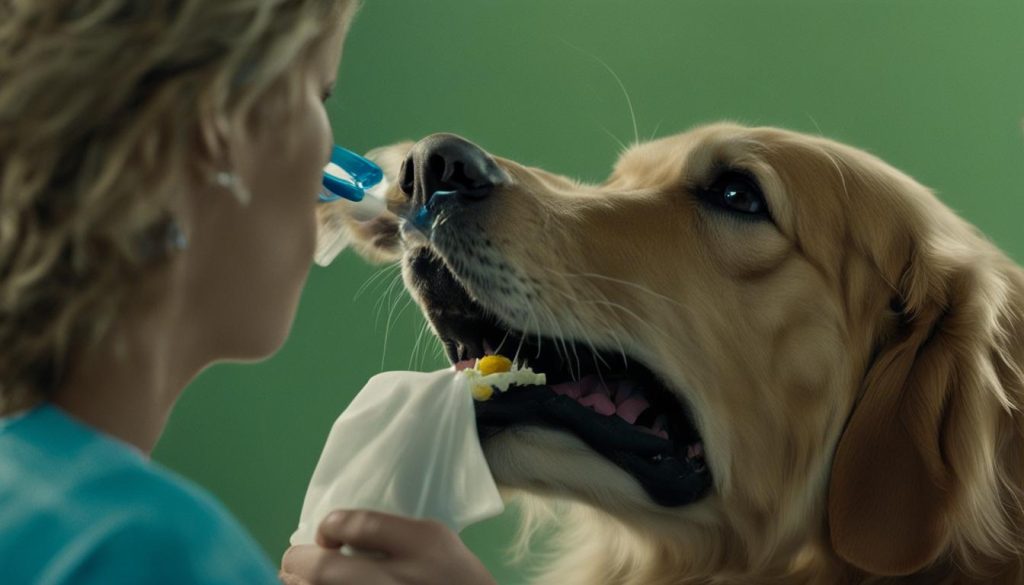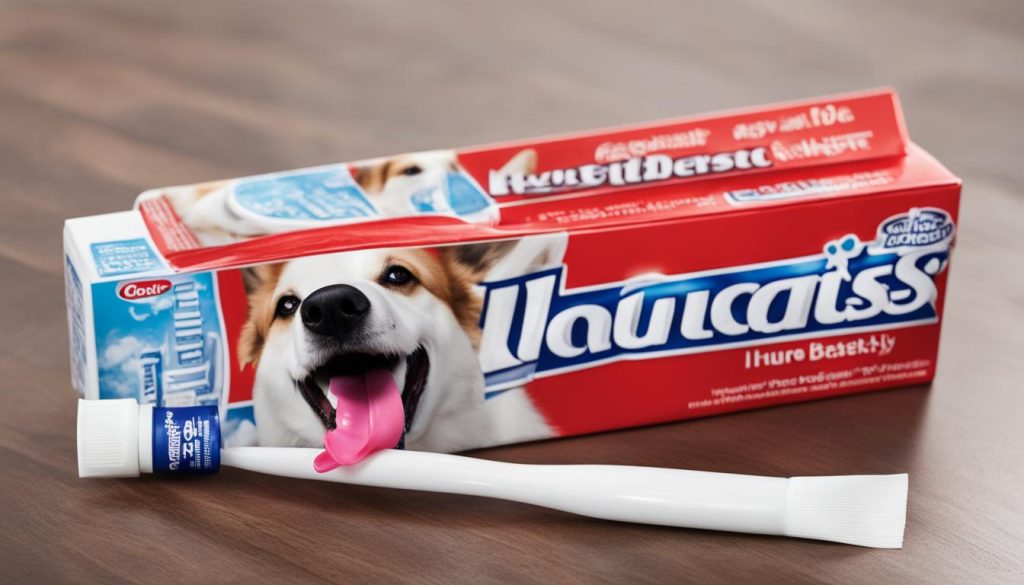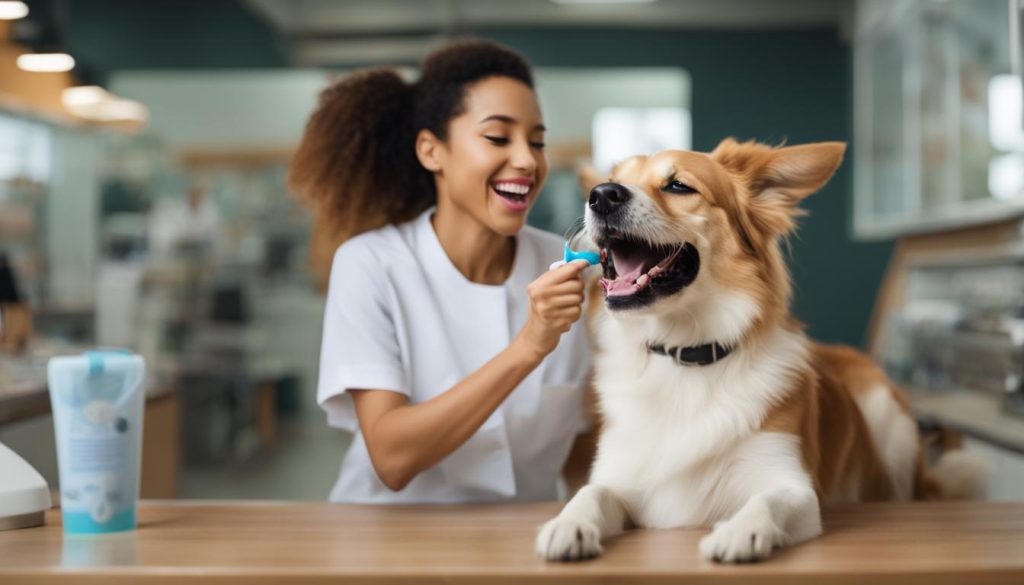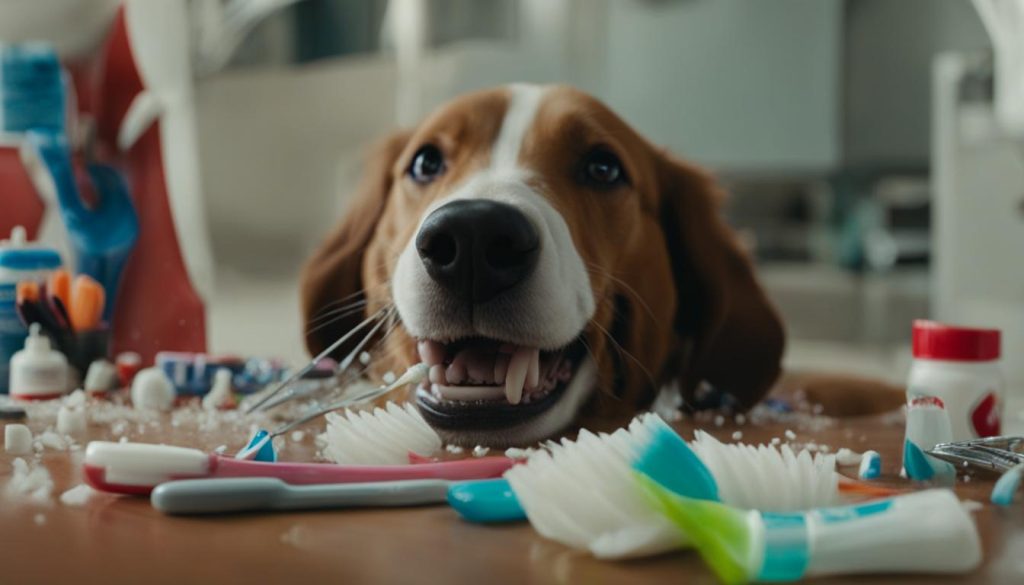Welcome to my expert’s guide on how to brush your dog’s teeth. Proper dental care is essential for your furry friend’s overall health and well-being. Did you know that over 80% of dogs over the age of three suffer from periodontal disease? This can lead to tooth loss if left untreated. But don’t worry, with the right techniques and tools, you can easily maintain your dog’s dental health.
Brushing your dog’s teeth at least twice a day is recommended to remove plaque and prevent tartar buildup. Ideally, start teaching your dog to accept tooth brushing while they are still a puppy. However, it is never too late to train an older dog. Just remember to be patient and consistent in your efforts.
Before we begin, you should never use human toothpaste on your dog, as it contains ingredients that can be harmful to them. Instead, opt for toothpaste specifically formulated for dogs, which comes in a variety of flavors that they find appetizing.
In this guide, I will take you through the importance of brushing your dog’s teeth, when and how often to brush, techniques to train your dog to accept tooth brushing, choosing the right toothbrush and toothpaste, proper brushing techniques, and additional tips for success. By following these steps, you will ensure your dog’s dental health is in top shape.
Key Takeaways:
- Regularly brushing your dog’s teeth helps prevent plaque accumulation and reduces the risk of gum disease and tooth decay.
- Choose a quiet time and place to begin tooth brushing and gradually introduce the toothbrush.
- Use a toothbrush specifically designed for dogs and toothpaste formulated for canine use.
- Focus on the outside surfaces of the teeth where plaque accumulates the most.
- Establish a daily brushing routine and be patient with older dogs who may take longer to accept tooth brushing.
The Importance of Brushing Dog’s Teeth

The importance of brushing your dog’s teeth cannot be overstated when it comes to maintaining their oral hygiene and overall health. Canine dental health is a crucial aspect of their well-being, as it directly impacts their ability to eat, chew, and enjoy a pain-free life.
Regular brushing helps prevent the accumulation of plaque, which is a sticky film of bacteria that forms on the teeth. If left untreated, plaque can harden into tartar, leading to gum disease, tooth decay, and even tooth loss. By brushing your dog’s teeth, you remove plaque, reduce the risk of gum disease, and maintain clean and healthy teeth.
Proper dental care for dogs not only prevents oral problems but also helps prevent bacterial infections that can spread to other organs. By promoting your dog’s oral hygiene, you are taking a proactive approach to their overall well-being.
Brushing your dog’s teeth also helps combat bad breath, a common issue among dogs. Regular brushing eliminates bacteria and food particles that can cause unpleasant odors, leaving your dog with fresh breath and a more enjoyable cuddle experience.
| Benefits of Brushing Dog’s Teeth: |
|---|
| Prevents plaque and tartar buildup |
| Reduces the risk of gum disease and tooth decay |
| Maintains clean and healthy teeth |
| Prevents bad breath |
| Supports overall dental health and well-being |
When and How Often to Brush Your Dog’s Teeth

Brushing your dog’s teeth is an essential part of their dental care routine. Regular brushing helps prevent plaque buildup, reduces the risk of gum disease, and maintains overall oral hygiene. But when should you brush your dog’s teeth, and how often?
The recommended frequency for brushing your dog’s teeth is at least twice a day. Establishing a daily routine can help your dog become accustomed to the process and make tooth brushing more manageable. Choose a quiet time and place to begin the brushing session, making sure both you and your dog are relaxed.
If you have an older dog who is not used to tooth brushing, it may take longer to train them to accept it. However, with patience and persistence, you can gradually introduce tooth brushing into their routine. Start by rubbing your finger or a soft cloth over their teeth to get them used to the sensation. Then, gradually transition to using a toothbrush designed specifically for dogs.
While brushing your dog’s teeth twice a day is ideal, it may not always be feasible. If that’s the case, brushing at least three times a week is the minimum recommendation to help remove plaque and prevent tartar accumulation. Remember, consistency is key in maintaining your dog’s dental health!
Benefits of Regular Tooth Brushing:
- Prevents plaque buildup
- Reduces the risk of gum disease
- Maintains overall oral hygiene
Table: Recommended Frequency of Brushing Dog’s Teeth
| Dog’s Age | Frequency of Brushing |
|---|---|
| Puppy | At least twice a day |
| Adult Dog | At least three times a week |
| Senior Dog | At least three times a week |
“Brushing your dog’s teeth at least three times a week can help prevent dental problems and promote their overall health.” – Dr. Emily Richards, Veterinary Dentist
Teaching Your Dog to Accept Tooth Brushing

To successfully brush your dog’s teeth, it is essential to make the experience positive for both of you. Here are some techniques you can use to teach your dog to accept tooth brushing:
- Choose a quiet and calm time and place to start the training process.
- If your dog is small enough, hold them securely in your lap with their head facing away from you. If your dog is larger, sit on a chair and have your dog sit beside you.
- Start by rubbing your finger or a soft cloth over the outer surfaces of your dog’s teeth, using a back-and-forth motion.
- Gradually introduce toothpaste by letting them taste a small amount from your finger.
- Once they are comfortable, apply a small amount of toothpaste to the cloth and rub it over their teeth.
- When they are used to this, transition to using a toothbrush designed for dogs.
- Praise and reward your dog throughout the whole procedure to make it a positive experience for them.
By following these techniques, you can slowly introduce your dog to tooth brushing and help them become more comfortable with the process.
“Teaching your dog to accept tooth brushing may take time and patience, but it is worth the effort for their dental health.”
Benefits of teaching your dog to accept tooth brushing
Teaching your dog to accept tooth brushing offers several benefits for their dental health:
- Prevents tartar buildup: Regular brushing helps remove plaque and prevent tartar accumulation, reducing the risk of gum disease and tooth decay.
- Improves oral hygiene: Brushing your dog’s teeth helps maintain overall oral hygiene, preventing bacterial infections that can spread to other organs.
- Freshens breath: Brushing eliminates bacteria that cause bad breath, keeping your dog’s breath fresh.
- Promotes overall health: Good dental health is linked to better overall health in dogs, as dental problems can lead to more severe health issues.
By teaching your dog to accept tooth brushing, you are investing in their long-term dental health and overall well-being.
Choosing the Right Toothbrush for Your Dog
When it comes to maintaining your dog’s oral hygiene, using the right toothbrush is essential. There are various toothbrush options available for dogs, each with its own advantages. Here are some of the best toothbrush options for dogs:
1. Standard Toothbrush
A standard toothbrush designed specifically for dogs is an excellent choice for most pet owners. These toothbrushes typically have soft bristles and come in various sizes to accommodate different dog breeds. The long handle makes it easier to reach the back teeth and maintain a firm grip while brushing.
2. Finger Toothbrush
If you find it challenging to maneuver a regular toothbrush inside your dog’s mouth, a finger toothbrush can be a great alternative. This type of toothbrush fits over your finger, allowing for more control and precision during brushing. It’s particularly useful for puppies and dogs who are new to tooth brushing.
3. Dual-Ended Toothbrush
A dual-ended toothbrush features bristles on both ends, with different sizes or angles. This design allows for more thorough cleaning in hard-to-reach areas. One end may have smaller bristles for the front teeth, while the other end is larger for the back teeth. Dual-ended toothbrushes are especially useful for dogs with different tooth sizes or breeds with shorter snouts.
4. Electric Toothbrush
For pet owners who want to level up their dog’s dental care routine, an electric toothbrush designed for dogs can be a game-changer. These toothbrushes usually feature rotating or vibrating bristles that effectively remove plaque and tartar. However, it is essential to introduce your dog to the sensation slowly and ensure they are comfortable with the noise and vibration before using an electric toothbrush regularly.
Remember, when selecting a toothbrush for your dog, consider their size, breed, and personal preference. It’s always a good idea to consult with your veterinarian for guidance on the best toothbrush option for your furry friend.
Selecting the Right Toothpaste for Your Dog

When it comes to brushing your dog’s teeth, using the right toothpaste is essential for their dental health. It is crucial to choose toothpaste specifically formulated for dogs, as human toothpaste can contain ingredients that may be harmful if swallowed. Pet toothpaste comes in various flavors that dogs find appetizing, making the tooth brushing experience more enjoyable for them.
When selecting a toothpaste for your dog, look for options that are approved by the Veterinary Oral Health Council (VOHC). This ensures that the toothpaste meets certain standards of efficacy. Pet toothpastes are available in a range of flavors, including poultry, beef, malt, and mint. By using a toothpaste that tastes good to your dog, you can make the tooth brushing process more pleasant and rewarding for both of you.
“Using a toothpaste that tastes good to your dog will make the tooth brushing experience more enjoyable for them.”
Avoid using household products such as baking soda, as they can have an unpleasant taste for your dog and may upset their stomach. Stick to toothpaste specifically designed for dogs to ensure their safety and well-being. By using the right toothpaste, you can effectively remove plaque, prevent tartar buildup, and maintain your dog’s dental health. Remember to consult with your veterinarian for recommendations on the best toothpaste option for your dog’s specific needs.
| Benefits of Using Pet Toothpaste |
|---|
| Pet toothpaste is safe for dogs to swallow |
| Pet toothpaste comes in appetizing flavors |
| Using pet toothpaste changes the pH of your dog’s mouth, preventing plaque formation |
| Pet toothpaste kills bacteria and improves gum health |
| Using pet toothpaste keeps your dog’s teeth cleaner, gums healthier, and breath fresher |
To summarize, choosing the right toothpaste for your dog is crucial in maintaining their oral health. Pet toothpaste offers safety, delicious flavors, and specific benefits that promote good dental hygiene. By using toothpaste designed for dogs, you can make the tooth brushing experience enjoyable for your furry friend while effectively preserving their dental well-being.
How to Brush Your Dog’s Teeth

Brushing your dog’s teeth is an important part of their overall dental care routine. By following a step-by-step guide, you can ensure that you are effectively cleaning your dog’s teeth and maintaining their oral hygiene. Here is a detailed description of the brushing technique for dogs:
Step 1: Gather Your Tools
Before you begin brushing your dog’s teeth, make sure you have all the necessary tools. These include a toothbrush specifically designed for dogs and toothpaste formulated for pets. Avoid using human toothbrushes or toothpaste, as they may contain ingredients that can be harmful to your dog’s health.
Step 2: Introduce Toothpaste
Start by allowing your dog to taste a small amount of toothpaste from your finger. This helps familiarize them with the taste and texture of the toothpaste. Once they are comfortable with it, apply a small amount to the toothbrush.
Step 3: Brushing Technique
Gently lift your dog’s lip to expose their teeth. Begin brushing with back-and-forth motions on the front teeth, focusing on the area where the gum meets the tooth surface. Gradually work your way to the side and back teeth. Pay special attention to the outer surfaces of the teeth, as this is where plaque tends to accumulate the most. Aim to brush for about 30 seconds per side.
Remember to praise and reward your dog throughout the brushing process to make it a positive experience for them. Consistency is key, so aim to brush your dog’s teeth at least twice a day to maintain their oral health.
| Step | Description |
|---|---|
| Step 1 | Gather Your Tools |
| Step 2 | Introduce Toothpaste |
| Step 3 | Brushing Technique |
Additional Tips for Brushing Your Dog’s Teeth

Successfully brushing your dog’s teeth requires patience, consistency, and a positive approach. Here are some additional tips to ensure toothbrushing success for your furry friend:
1. Introduce toothbrushing gradually:
Start by gently massaging your dog’s gums with your finger or a soft cloth to familiarize them with the sensation. Gradually introduce the toothbrush, allowing them to sniff and lick it before proceeding to brush their teeth. This gradual approach helps reduce anxiety and makes the experience more comfortable for your dog.
2. Use positive reinforcement:
Throughout the toothbrushing process, praise and reward your dog with treats or verbal encouragement. This positive reinforcement reinforces the idea that toothbrushing is a rewarding and enjoyable activity. It also helps build a positive association with the toothbrushing routine.
3. Be patient and gentle:
If your dog initially resists or becomes anxious during toothbrushing, remain calm and patient. Take breaks if necessary and gradually increase the brushing duration over time. Use gentle, circular motions to brush the teeth, focusing on the gumline where plaque tends to accumulate.
4. Regularly inspect your dog’s mouth:
In addition to brushing, regularly inspect your dog’s mouth for signs of dental issues such as red or swollen gums, tartar buildup, loose teeth, or bad breath. Early detection can prevent further complications and ensure prompt treatment if needed.
By following these additional tips, you can create a positive and effective toothbrushing routine for your dog, promoting their dental health and overall well-being. Remember, consistency and patience are key to achieving toothbrushing success!
The Importance of Dental Care at Home for Dogs
Dental care is an essential aspect of maintaining your dog’s overall health and well-being. Just like humans, dogs can develop dental problems that, if left untreated, can lead to pain, discomfort, and even more serious health issues. By implementing a regular dental care routine at home, you can prevent dental problems and ensure that your furry friend enjoys a healthy and happy life.
Canine dental care involves more than just brushing your dog’s teeth. It also includes regular check-ups with a veterinarian, a balanced diet, and the appropriate chew toys. However, a significant part of dental care starts at home, with daily brushing and other preventive measures.
Regular brushing helps remove plaque, tartar, and food particles from your dog’s teeth, reduces the risk of gum disease, and freshens their breath. It is recommended to use a toothbrush and toothpaste specifically designed for dogs. Additionally, there are dental treats and water additives available that can help complement your dog’s dental care routine.
By prioritizing home dental care for dogs, you can prevent dental problems and maintain your dog’s oral health. Taking a proactive approach to their dental care not only ensures a bright and healthy smile but also contributes to their overall well-being and happiness.
| Benefits of Canine Dental Care at Home |
|---|
| Prevents plaque and tartar buildup |
| Reduces the risk of gum disease |
| Helps maintain fresh breath |
| Prevents tooth decay and loss |
| Improves overall oral hygiene |
| Reduces the risk of systemic diseases caused by oral bacteria |
By dedicating time and effort to your dog’s dental care routine, you can prevent dental problems and ensure their long-term oral health. Remember to consult with your veterinarian for guidance on the best dental care practices for your furry friend, as every dog is unique and may require specific attention. With proper care, your dog can have a healthy and happy smile for years to come.
The Role of Pet Toothpaste in Dental Care
Pet toothpaste plays a significant role in dental care for dogs. It is specially formulated to be safe for dogs to swallow and comes in appetizing flavors that make tooth brushing more enjoyable for them. Pet toothpaste helps change the pH of your dog’s mouth, preventing plaque formation, killing bacteria, and improving gum health. Using a good pet toothpaste can keep your dog’s teeth cleaner, gums healthier, and breath fresher. Opt for toothpaste that has been approved by the Veterinary Oral Health Council (VOHC) for added assurance of its effectiveness.
“Using pet toothpaste is essential for maintaining your dog’s oral hygiene. It contains ingredients that are safe for dogs and helps prevent plaque and tartar buildup. By using pet toothpaste regularly, you can keep your dog’s teeth clean and reduce the risk of dental disease.”
In addition to regular tooth brushing, using pet toothpaste is an effective way to support your dog’s dental health. It complements the mechanical action of brushing by providing additional benefits that promote oral hygiene. The flavorful options available in pet toothpaste make the tooth brushing experience more pleasant for dogs, increasing their cooperation and making the process easier for pet owners. Incorporating pet toothpaste into your dog’s dental care routine can significantly contribute to their overall dental health.
| Benefits of Pet Toothpaste |
|---|
| Promotes clean teeth |
| Prevents plaque and tartar buildup |
| Kills bacteria in the mouth |
| Improves gum health |
| Makes tooth brushing enjoyable for dogs |
Using pet toothpaste is a key component of a comprehensive dental care routine for dogs. By combining regular brushing with the right toothpaste, you can ensure that your dog maintains optimal oral health and enjoys fresh breath. Remember to consult with your veterinarian for recommendations on the best pet toothpaste for your dog’s specific needs and preferences.
Other Methods to Reduce Tartar Buildup in Dogs
While regular tooth brushing is the best way to prevent tartar buildup in dogs, there are some alternative methods you can use to supplement their dental care routine. These methods can help reduce the accumulation of plaque and keep your dog’s teeth and gums healthy. Here are a few options to consider:
1. Dental Chews and Treats:
Dental chews and treats are designed to promote chewing, which helps remove plaque from your dog’s teeth. Look for products that have the Veterinary Oral Health Council (VOHC) seal of approval, as they have been tested and proven to be effective in reducing tartar buildup.
2. Water Additives:
Water additives are solutions that you can add to your dog’s water dish. These additives contain chemicals that help retard plaque formation and reduce the risk of tartar buildup. It’s important to choose products that are specifically formulated for dogs and approved by veterinarians.
3. Dental Toys:
There are various dental toys available that are designed to promote chewing and help remove plaque. These toys often have textured surfaces that can effectively clean your dog’s teeth while they play. Make sure to choose toys that are safe and suitable for your dog’s size and chewing habits.
| Method | Description |
|---|---|
| Dental Chews and Treats | Promote chewing and help remove plaque from teeth |
| Water Additives | Retard plaque formation and reduce tartar buildup |
| Dental Toys | Promote chewing and help clean teeth while playing |
Remember, while these alternative methods can be beneficial, they should not replace regular tooth brushing. It’s important to establish a dental care routine that includes daily tooth brushing along with these supplementary measures. Consulting with your veterinarian can help you determine the most suitable dental care plan for your dog’s specific needs. By combining these methods, you can help reduce tartar buildup in your dog’s mouth and promote their overall dental health.
Wrapping Up
To summarize, brushing your dog’s teeth is an essential part of their overall dental care. By establishing a regular brushing routine and using the appropriate toothbrush and toothpaste, you can effectively remove plaque, prevent tartar buildup, and reduce the risk of dental problems in your dog.
Remember to start brushing your dog’s teeth early and make the experience positive by using praise and rewards. Choose a quiet and calm time for brushing, and gradually introduce the toothbrush to your dog’s mouth. Focus on the outside surfaces of the teeth, where plaque accumulates the most.
By dedicating time and effort to brushing your dog’s teeth, you are promoting their oral health and overall well-being. Good dental hygiene can prevent issues such as gum disease, tooth decay, and tooth loss, as well as systemic diseases caused by oral bacteria.
In summary, by following the guidelines provided in this dog teeth brushing guide, you can ensure that your dog’s teeth stay clean, healthy, and free from dental problems. With consistency and proper care, you can protect your dog’s dental health for years to come.
FAQ
How often should I brush my dog’s teeth?
It is recommended to brush your dog’s teeth at least twice a day.
Can I train my older dog to accept tooth brushing?
Yes, it is still possible to train older dogs to accept tooth brushing.
What type of toothbrush should I use for my dog?
There are various toothbrush options available for dogs, including brushes with angled handles, multiple heads, small brushes, and finger toothbrushes. Consult with your veterinarian for guidance on the best toothbrush option for your dog.
Can I use human toothpaste to brush my dog’s teeth?
No, you should never use human toothpaste on dogs, as it contains ingredients that can be harmful to them. Use toothpaste specifically formulated for dogs.
How do I brush my dog’s teeth?
Start by applying a small amount of pet toothpaste to a toothbrush designed for dogs. Gently raise your dog’s lip to expose the teeth and use back-and-forth motions to brush the front, side, and back teeth. Concentrate on the outside surfaces of the teeth. Brush for approximately 30 seconds per side.
How can I make tooth brushing a positive experience for my dog?
Praise and reward your dog throughout the entire tooth brushing process to make it a positive experience for them.
What are the benefits of brushing my dog’s teeth?
Regular brushing helps prevent plaque accumulation, fights bad breath, reduces the risk of gum disease, tooth decay, and tooth loss, and maintains overall oral hygiene. It also prevents bacterial infections that can spread to other organs.
Are there alternative methods to reduce tartar buildup in dogs?
Yes, there are dental chews, treats, toys, and water additives available that can help reduce tartar buildup. However, these methods should not replace regular tooth brushing.
Why is dental care at home important for dogs?
Dental care at home helps maintain your dog’s oral health, prevents plaque accumulation, reduces the risk of gum disease, and prevents more severe problems such as tooth decay and tooth loss. It also promotes their overall health and well-being.
What is the role of pet toothpaste in dental care for dogs?
Pet toothpaste is specially formulated to be safe for dogs to swallow and comes in appetizing flavors. It helps prevent plaque formation, kills bacteria, improves gum health, and keeps your dog’s teeth clean, gums healthy, and breath fresh.






